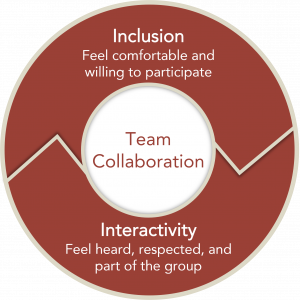
- Dale Ludwig Leadership, Meetings
Inclusiveness and Interactivity
The first article in this two-part series focused on the planning required for successful team collaboration. It focused on framing meetings to feel relevant, focused, and efficient for participants.
This article will look at what meeting facilitators can do to encourage collaboration during the meeting. Successful collaboration serves both the team involved and the organization it is part of. In an increasingly diverse workforce, it’s not the organization’s goal to smooth over differences among people. Rather, the business goal is to respect, embrace, and take advantage of these differences. For that to happen, meeting participants must feel two things—a sense of belonging and a willingness to participate.
To focus on how these goals are met, we will look at team collaboration through a leadership lens. In All the Leader You Can Be, Suzanne Bates outlines behaviors that contribute to effective leadership. Two of these behaviors play an important role in team meetings, inclusiveness, and interactivity. Inclusiveness is about making people feel a sense of belonging. In a meeting, that leads to participants that are ready and willing to collaborate. Interactivity is about using a conversation to get the work of the meeting done. When meetings are genuinely interactive, participants feel heard, respected, and part of the group.
In the meeting context, these two goals are strongly linked. Interactivity leads to a sense of inclusion. Feelings of inclusion lead to a willingness to participate in the meeting’s conversation.
Inclusiveness
In her book, which we highly recommend, Bates defines inclusiveness as “Actively involving others, welcoming diverse points of view, encouraging ownership in mission, and empowering initiative.” When applied to team collaboration, these behaviors yield these results: team members feel a sense of belonging, purpose, and comfort. Keep in mind that inclusiveness is defined by what individual members of the team feel during the meeting. It’s not about the leader’s sense of what he or she is doing or what intentions they may have. It’s about the response of the other people in the room.
Without a feeling of inclusiveness
- Participants won’t feel comfortable enough to interact
- Walls are built between the facilitator and between individuals in the group
- Fruitful interactivity is impossible to achieve
The result is that some team members feel like less-than-fully respected members of the team.
Team leaders need to be aware and empathetic and do everything in their power to make all members of the team feel comfortable. They should never assume that inclusiveness has been fully achieved. You’re always striving for it. Here are a few recommendations.
- Listen fearlessly. Don’t be afraid of disagreement or differing points of view.
- Be sensitive not only to how people are responding to you but also to how they are responding to each other.
- Avoid showing preferences for individuals who are like you. Be sure to include people with different experiences or outlooks, age or gender, nationality, sexual orientation, or gender identity.
Meeting facilitators are responsible for creating the conditions for a fruitful discussion, which brings us to interactivity.
Interactivity
Bates defines interactivity as “promoting an interpersonal style of dialog and timely exchange of information and questions to coordinate action.” When these behaviors are applied to collaborative team meetings, they lead to a meeting that succeeds through the conversation that takes place.
When this doesn’t happen, interactivity and inclusiveness suffer:
- People will not want to participate because it’s clear the facilitator does not want interaction. The meeting “should have been an email.”
- The meeting feels like a waste of time.
- Inclusion suffers because individuals feel their participation isn’t needed or wanted.
A successful facilitator understands that interactivity is the purpose of the meeting. They go into their meetings with this mindset:
- They recognize the effort it takes for some people to contribute and so they do what it takes to make participants willing to take the risk.
- They show respect for all perspectives.
- They take responsibility for connecting the dots, making it easy for everyone to follow the conversation.
- They are willing to let the conversation go farther than they may feel it should.
The next time you’re facilitating a collaborative meeting, remember that inclusiveness encourages interaction, and an interactive meeting is an inclusive meeting.


